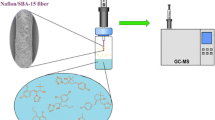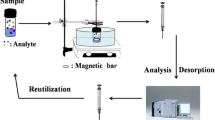Abstract
In this study, a facile route for the preparation of biochar coated fiber via dip method was built. The uniform biochar was produced by thermal decomposition of pine needles under limited or absence of oxygen. The robust adhesion of biochar to the etched stainless steel support was ensured by the viscosity of epoxy resin. The obtained fiber was utilized for headspace solid-phase micro-extraction (HS-SPME) of polychlorinated biphenyls (PCBs) from aqueous solution. The results of orthogonal experiment suggested that the maximum extraction efficiency for the target PCBs compounds was obtained when the extraction temperature, extraction time and the pyrolysis temperature of biochar were 60 °C, 30 min and 400 °C, respectively. Under the optimized conditions, the developed method showed good linearity between 40 and 320 ng L−1 with correlation coefficients (R) in the range of 0.9817–0.9936. The limits of detection (LOD) ranged from 12.3 to 24.3 ng L−1. The reproducibility for fiber-to-fiber obtained on two fibers was in the range of 9.5–20.4 %. The precisions for run-to-run found for 5 extraction times using one fiber in 1 day was less than 27.8 %. The relative standard deviations (RSD) for day-to-day achieved for 5 days was less than 22.4 %.




Similar content being viewed by others
References
Arthur CL, Pawliszyn J, Chem A (1990) Solid phase microextraction with thermal desorption using fused silica optical fibers. Anal Chem 62(19):2145–2148
Mehdinia A, Roohi F, Jabbari A, Manafi MR (2011) Self-doped polyaniline as new polyaniline substitute for solid-phase microextraction. Anal Chim Acta 683(2):206–211. doi:10.1016/j.aca.2010.10.031
Bagheri H, Roostaie A (2012) Aniline–silica nanocomposite as a novel solid phase microextraction fiber coating. J Chromatogr A 1238:22–29. doi:10.1016/j.chroma.2012.03.027
Canellas E, Vera P, Nerín C (2016) Multiple headspace-solid phase microextraction for the determination of migrants coming from a self-stick label in fresh sausage. Food Chem 197(Part A):24–29. doi:10.1016/j.foodchem.2015.10.039
Hu G, Zhu Y, Hernandez M, Koutchma T, Shao S (2016) An efficient method for the simultaneous determination of furan, 2-methylfuran and 2-pentylfuran in fruit juices by headspace solid phase microextraction and gas chromatography–flame ionisation detector. Food Chem 192:9–14. doi:10.1016/j.foodchem.2015.06.100
Olszowy P, Szultka M, Nowaczyk J, Buszewski B (2011) A new way of solid-phase microextraction fibers preparation for selected antibiotic drug determination by HPLC–MS. J Chromatogr B 879(25):2542–2548. doi:10.1016/j.jchromb.2011.07.007
Mikš-Krajnik M, Yoon Y-J, Ukuku DO, Yuk H-G (2016) Volatile chemical spoilage indexes of raw Atlantic salmon (Salmo salar) stored under aerobic condition in relation to microbiological and sensory shelf lives. Food Microbiol 53(Part B):182–191. doi:10.1016/j.fm.2015.10.001
Jiménez-Martín E, Gharsallaoui A, Pérez-Palacios T, Ruiz Carrascal J, Antequera Rojas T (2015) Volatile compounds and physicochemical characteristics during storage of microcapsules from different fish oil emulsions. Food Bioprod Process 96:52–64. doi:10.1016/j.fbp.2015.07.005
Kumar A, Gaurav Malik AK, Tewary DK, Singh B (2008) A review on development of solid phase microextraction fibers by sol–gel methods and their applications. Anal Chim Acta 610(1):1–14. doi:10.1016/j.aca.2008.01.028
Li J-W, Wang Y-L, Yan S, Li X-J, Pan S-Y (2016) Molecularly imprinted calixarene fiber for solid-phase microextraction of four organophosphorous pesticides in fruits. Food Chem 192:260–267. doi:10.1016/j.foodchem.2015.07.018
Poole CF, Lenca N (2015) Green sample-preparation methods using room-temperature ionic liquids for the chromatographic analysis of organic compounds. TrAC Trends Anal Chem 71:144–156. doi:10.1016/j.trac.2014.08.018
Mehdinia A, Bahrami M, Mozaffari S (2015) A comparative study on different functionalized mesoporous silica nanomagnetic sorbents for efficient extraction of parabens. J Iran Chem Soc 12(9):1543–1552. doi:10.1007/s13738-015-0626-8
Wang X, Wang Y, Qin Y, Ding L, Chen Y, Xie F (2015) Sensitive and selective determination of polycyclic aromatic hydrocarbons in mainstream cigarette smoke using a graphene-coated solid-phase microextraction fiber prior to GC/MS. Talanta 140:102–108. doi:10.1016/j.talanta.2015.03.030
Heidari M, Bahrami A, Ghiasvand AR, Shahna FG, Soltanian AR (2012) A novel needle trap device with single wall carbon nanotubes sol–gel sorbent packed for sampling and analysis of volatile organohalogen compounds in air. Talanta 101:314–321. doi:10.1016/j.talanta.2012.09.032
Shih Y-H, Lirio S, Li C-K, Liu W-L, Huang H-Y (2016) Determination of imidazole derivatives by micellar electrokinetic chromatography combined with solid-phase microextraction using activated carbon-polymer monolith as adsorbent. J Chromatogr A 1428:336–345. doi:10.1016/j.chroma.2015.08.067
Liu Q, Cheng M, Long Y, Yu M, Wang T, Jiang G (2014) Graphenized pencil lead fiber: facile preparation and application in solid-phase microextraction. J Chromatogr A 1325:1–7. doi:10.1016/j.chroma.2013.11.051
Djozan D, Baheri T, Farshbaf R, Azhari S (2005) Investigation of solid-phase microextraction efficiency using pencil lead fiber for in vitro and in vivo sampling of defensive volatiles from insect’s scent gland. Anal Chim Acta 554(1–2):197–201. doi:10.1016/j.aca.2005.08.049
Li L, Hongwen S, Ya L, Yuchao L, Zhongyao L, Peng Z, Hongwen S (2011) Review on environmental effects and application of biochar. Environ Chem 30(08):1411–1421
Inyang M, Dickenson E (2015) The potential role of biochar in the removal of organic and microbial contaminants from potable and reuse water: a review. Chemosphere 134:232–240. doi:10.1016/j.chemosphere.2015.03.072
Ahmad M, Rajapaksha AU, Lim JE, Zhang MW, Bolan N, Molan D, Vithanage M, Lee SS, OK YS, (2013) Biochar as a sorbent for contaminant management in soil and water: a review. Chemosphere 99(3):203–203
Mohan D, Sarswat A, Yong SO, Pittman CU (2014) Organic and inorganic contaminants removal from water with biochar, a renewable, low cost and sustainable adsorbent—a critical review. Bioresour Technol 160(5):191–202
Aziz-Zanjani MO, Mehdinia A (2014) A review on procedures for the preparation of coatings for solid phase microextraction. Microchim Acta 181(11–12):1169–1190
Yu H, Ho TD, Anderson JL (2013) Ionic liquid and polymeric ionic liquid coatings in solid-phase microextraction. TrAC Trends Anal Chem 45:219–232. doi:10.1016/j.trac.2012.10.016
Loh SH, Sanagi MM, Wan Ibrahim WA, Hasan MN (2013) Multi-walled carbon nanotube-impregnated agarose film microextraction of polycyclic aromatic hydrocarbons in green tea beverage. Talanta 106:200–205. doi:10.1016/j.talanta.2012.12.032
Xiao CH, Liu ZL, Wang ZY, Wu CY, Han HM (2000) Use of polymeric fullerene as a new coating for solid-phase microextraction. Chromatographia 52(11–12):803–809
Chen W, Zeng J, Chen J, Huang X, Jiang Y, Wang Y, Chen X (2009) High extraction efficiency for polar aromatic compounds in natural water samples using multiwalled carbon nanotubes/Nafion solid-phase microextraction coating. J Chromatogr A 1216(52):9143–9148. doi:10.1016/j.chroma.2009.07.025
Eisler R (1986) Polychlorinated biphenyl hazards to fish, wildlife, and invertebrates: a synoptic review. US fish and Wildlife Service Patuxent Wildlife Research Center Laurel Md biological Report, Palala Press, pp 84. ISBN-10:1341776689, ISBN-13:9781341776687
Erickson MD, Kaley RG (2011) Applications of polychlorinated biphenyls. Environ Sci Pollut Res 18(2):135–151
Roszko M, Jędrzejczak R, Szymczyk K (2014) Polychlorinated biphenyls (PCBs), polychlorinated diphenyl ethers (PBDEs) and organochlorine pesticides in selected cereals available on the Polish retail market. Sci Total Environ 466–467:136–151. doi:10.1016/j.scitotenv.2013.07.016
Brouwer A, Winneke G (1999) Characterization of potential endocrine-related health effects at low-dose levels of exposure to PCBs. Environ Health Perspect 107 suppl 4(8):639–649
Leyla K, Ihsan A, Abdurrahman A (2009) Some organochlorine pesticide residues in fish species in Konya, Turkey. Chemosphere 74(7):885–889
Carpenter DO (2006) Polychlorinated biphenyls (PCBs): routes of exposure and effects on human health. Rev Environ Health 21(1):1–23
Kimbrough RD (1987) Human health effects of polychlorinated biphenyls (PCBs) and polybrominated biphenyls (PBBs). Annu Rev Pharmacol 27(1):87–111
Ying Y, Lei L, Zhenya S, Lu D (2012) The research on the surface oxidation modification of activated carbon and Its adsorption mechanisms of organic matter and heavy metal ions. Sci Technol Eng 12(24):6132–6138
Singh SR, Singh AP (2012) Treatment of water containg chromium (VI) using rice husk carbon as a newlow cost adsorbent. Int J Environ Res 6(4):917–924
Minori U, Wartelle LH, Thomas KK, Fortier CA, IM Lima (2011) Influence of pyrolysis temperature on biochar property and function as a heavy metal sorbent in soil. J Agric Food Chem 59(6):2501–2510
Durán-Jiménez G, Hernández-Montoya V, Montes-Morán MA, Teutli-León M (2015) New oxygenated carbonaceous adsorbents prepared by combined radiant/microwave heating for the removal of Pb2+ in aqueous solution. J Anal Appl Pyrol 113:599–605. doi:10.1016/j.jaap.2015.04.001
Lou L, Wu B, Wang L, Luo L, Xu X, Hou J, Xun B, Hu B, Chen Y (2011) Sorption and ecotoxicity of pentachlorophenol polluted sediment amended with rice-straw derived biochar. Bioresour Technol 102(5):4036–4041. doi:10.1016/j.biortech.2010.12.010
Baoliang C, Dandan Z, Lizhong Z (2008) Transitional adsorption and partition of nonpolar and polar aromatic contaminants by biochars of pine needles with different pyrolytic temperatures. Environ Sci Technol 42(14):5137–5143
Ma JC, Dougherty DA (1997) The cation–π interaction. Chem Rev 97:1303–1324
Zhu D, Herbert BE, Schlautman MA, Carraway ER (2004) Characterization of cation–π interactions in aqueous solution using deuterium nuclear magnetic resonance spectroscopy. J Environ Qual 33(1):276–284. doi:10.2134/jeq2004.2760
Müller S, Totsche KU, Kögel-Knabner I (2007) Sorption of polycyclic aromatic hydrocarbons to mineral surfaces. Eur J Soil Sci 58(4):918–931. doi:10.1111/j.1365-2389.2007.00930.x
Acknowledgments
This work was supported by the Anhui Normal University.
Author information
Authors and Affiliations
Corresponding author
Ethics declarations
Conflict of interest
Author Jing Li declares that she has no conflict of interest. Author Rui Chang declares that she has no conflict of interest. Author Fengqin Wang declares that she has no conflict of interest. Author Guang-Chao Zhao declares that he has no conflict of interest.
Ethical approval
This article does not contain any studies with human participants or animals performed by any of the authors.
Rights and permissions
About this article
Cite this article
Li, J., Chang, R., Wang, F.Q. et al. A Facile Solid-Phase Micro-Extraction Fiber Based on Pine Needles Biochar Coating for Extraction of Polychlorinated Biphenyls from Water Samples. Chromatographia 79, 1033–1040 (2016). https://doi.org/10.1007/s10337-016-3118-9
Received:
Accepted:
Published:
Issue Date:
DOI: https://doi.org/10.1007/s10337-016-3118-9




